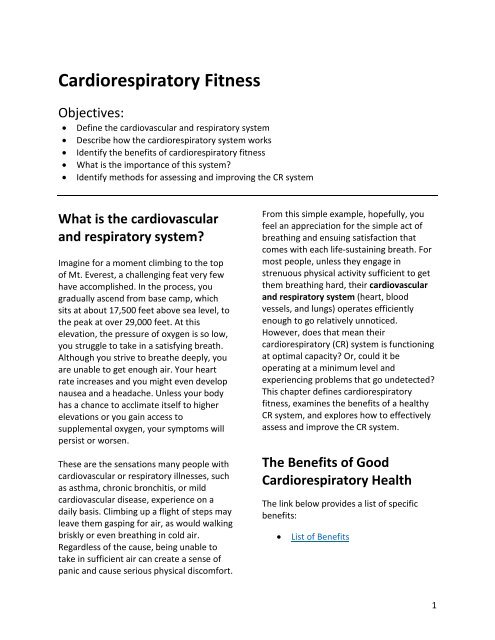Concepts of Fitness and Wellness 2e, 2018
Concepts of Fitness and Wellness 2e, 2018
Concepts of Fitness and Wellness 2e, 2018
You also want an ePaper? Increase the reach of your titles
YUMPU automatically turns print PDFs into web optimized ePapers that Google loves.
Cardiorespiratory <strong>Fitness</strong><br />
Objectives:<br />
• Define the cardiovascular <strong>and</strong> respiratory system<br />
• Describe how the cardiorespiratory system works<br />
• Identify the benefits <strong>of</strong> cardiorespiratory fitness<br />
• What is the importance <strong>of</strong> this system?<br />
• Identify methods for assessing <strong>and</strong> improving the CR system<br />
What is the cardiovascular<br />
<strong>and</strong> respiratory system?<br />
Imagine for a moment climbing to the top<br />
<strong>of</strong> Mt. Everest, a challenging feat very few<br />
have accomplished. In the process, you<br />
gradually ascend from base camp, which<br />
sits at about 17,500 feet above sea level, to<br />
the peak at over 29,000 feet. At this<br />
elevation, the pressure <strong>of</strong> oxygen is so low,<br />
you struggle to take in a satisfying breath.<br />
Although you strive to breathe deeply, you<br />
are unable to get enough air. Your heart<br />
rate increases <strong>and</strong> you might even develop<br />
nausea <strong>and</strong> a headache. Unless your body<br />
has a chance to acclimate itself to higher<br />
elevations or you gain access to<br />
supplemental oxygen, your symptoms will<br />
persist or worsen.<br />
These are the sensations many people with<br />
cardiovascular or respiratory illnesses, such<br />
as asthma, chronic bronchitis, or mild<br />
cardiovascular disease, experience on a<br />
daily basis. Climbing up a flight <strong>of</strong> steps may<br />
leave them gasping for air, as would walking<br />
briskly or even breathing in cold air.<br />
Regardless <strong>of</strong> the cause, being unable to<br />
take in sufficient air can create a sense <strong>of</strong><br />
panic <strong>and</strong> cause serious physical discomfort.<br />
From this simple example, hopefully, you<br />
feel an appreciation for the simple act <strong>of</strong><br />
breathing <strong>and</strong> ensuing satisfaction that<br />
comes with each life-sustaining breath. For<br />
most people, unless they engage in<br />
strenuous physical activity sufficient to get<br />
them breathing hard, their cardiovascular<br />
<strong>and</strong> respiratory system (heart, blood<br />
vessels, <strong>and</strong> lungs) operates efficiently<br />
enough to go relatively unnoticed.<br />
However, does that mean their<br />
cardiorespiratory (CR) system is functioning<br />
at optimal capacity? Or, could it be<br />
operating at a minimum level <strong>and</strong><br />
experiencing problems that go undetected?<br />
This chapter defines cardiorespiratory<br />
fitness, examines the benefits <strong>of</strong> a healthy<br />
CR system, <strong>and</strong> explores how to effectively<br />
assess <strong>and</strong> improve the CR system.<br />
The Benefits <strong>of</strong> Good<br />
Cardiorespiratory Health<br />
The link below provides a list <strong>of</strong> specific<br />
benefits:<br />
• List <strong>of</strong> Benefits<br />
1


















